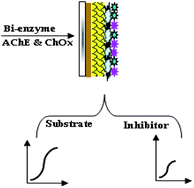A novel, unique gold–platinum bimetallic nanoparticles modified screen printed electrode (SPE) has been developed for the sensitive detection of paraoxon ethyl, carbofuran and simulant of nerve agent diisopropyl fluorophosphate (DFP), based on the enzyme inhibition approach. The gold–platinum nanoparticles were electrochemically deposited on a 3-aminopropyl triethoxy silane modified electrode. Following this acetylcholineesterase (AChE)/choline oxidase (ChOx) bienzymes were immobilized through cross-linking with glutaraldehyde onto a modified electrode. Electrodes were characterized by scanning electron microscopy (SEM), EDX (energy dispersive X-ray analysis) and cyclic voltammetry (CV). The bimetallic alloy nanoparticles have an excellent high surface area and the unique effect of electrocatalytic activity for the oxidation of hydrogen peroxide (H2O2). The IC50 values were determined for the inhibitors using immobilized enzymes on the modified electrode. Paraoxon ethyl, carbofuran, and DFP could be detected up to 0.20 μM, 0.20–0.25 μM, and 0.20–0.25 μM respectively at a 25–30% inhibition level of AChE enzyme (residual enzyme activity) with an incubation time of 10 min.

